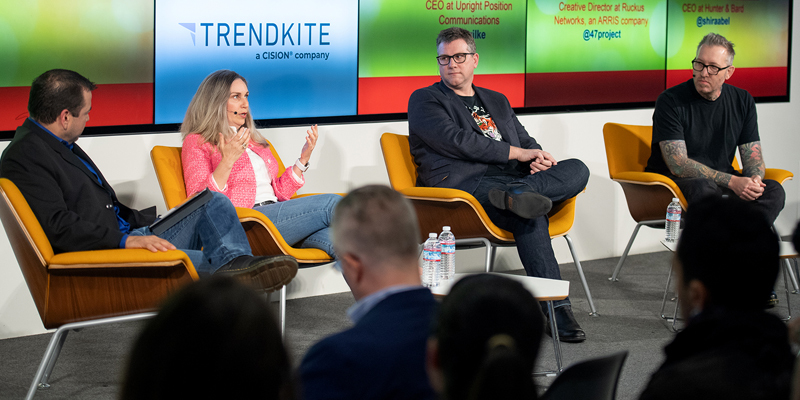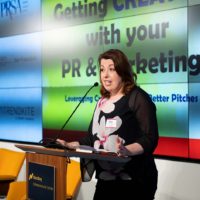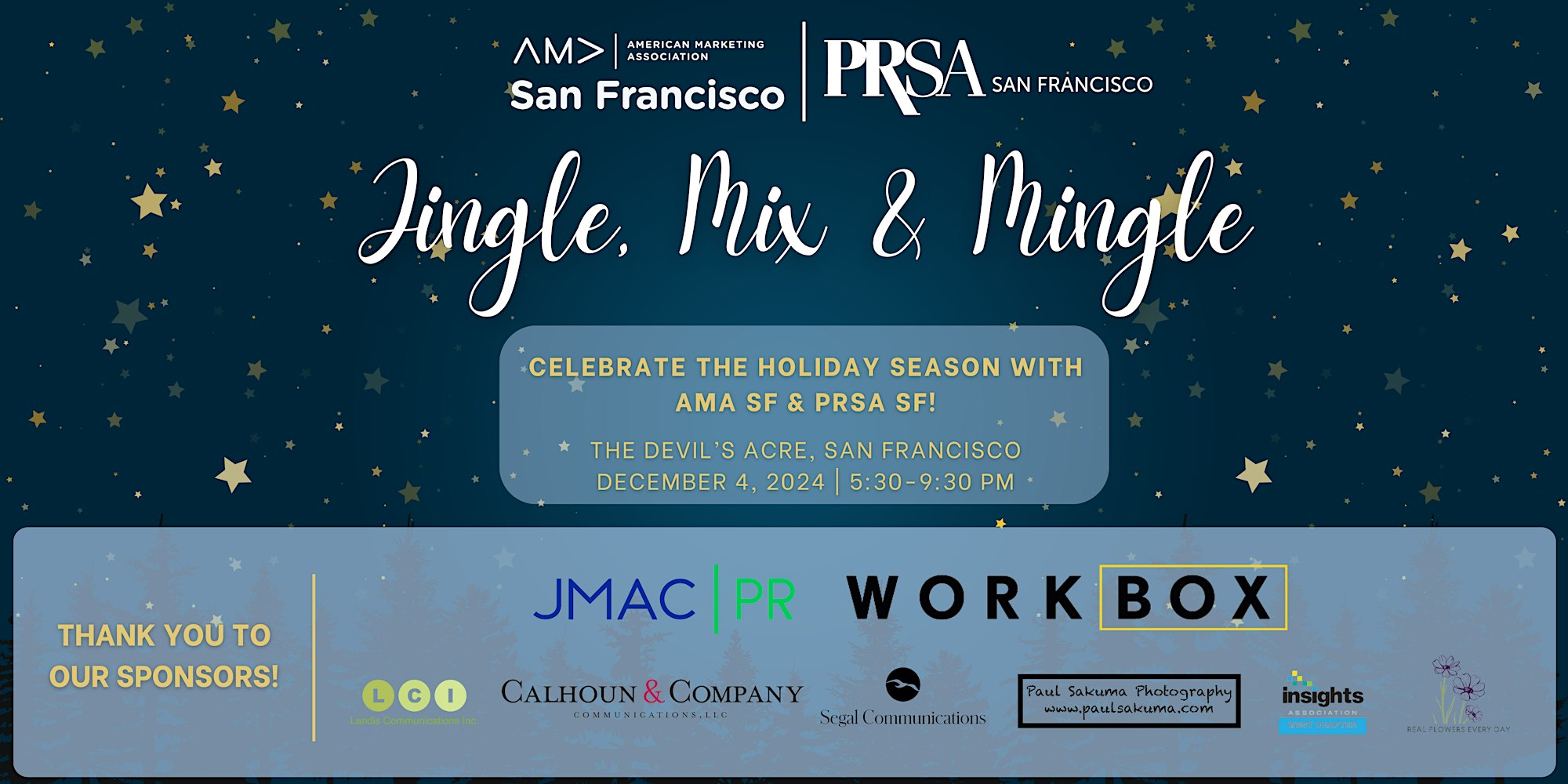Who better to bridge the gap between marketing and PR than the American Marketing Association of San Francisco (AMA SF) and the Public Relations Society of America, San Francisco (PRSA-SF). At their partnered event, Getting Creative with your PR: Leveraging Creative to Make Better Pitches, a panel comprised of three leaders in public relations held an insightful and harmonious dialectic on successful tactics for brand promotion—for use by marketers and PR pros alike.
As the affable host David Cardiel, Head of Demand Gen at Trendkite, introduced the evening’s speakers, it was evident that the personalities on stage were markedly distinct, yet they each had achieved industry success by leveraging their own unique strengths and perspectives.
About the Speakers
Shira Abel, CEO at Hunter & Bard
@shiraabel
Shira Abel is the CEO of Hunter & Bard, an award-winning public relations agency. She focuses on using creative PR and marketing strategies to achieve omnichannel results for clients. Years of experience working with clients across industries–from start-up to enterprise, and everything in between–has provided Shira with a clear understanding of what it takes to organically grow a company via digital engagement and brand awareness. She is an expert in creating higher Customer Lifetime Value through relationship building.
Rich Harris, Creative Director at Ruckus Networks, an ARRIS company
@47networks
Hailing from Scotts Valley, CA, Rich Harris from Ruckus Networks has been a creative in Silicon Valley for almost 25 years. A music composer, photographer, and aspiring filmmaker, he is all about content that moves the heart. In today’s business of PR, marketing and the battle against the short-attention span, there’s an art to moving people with engaging content that is short, sweet and thoughtful, yet high production quality without a Hollywood budget. This is where Rich comes in.
Paul Wilke, CEO at Upright Position Communications
@pwilke
Prior to founding Upright Position Communications in 2012, Paul headed public relations for Splunk, where he led communications around one of this decade’s most successful IPOs. Before Splunk, Paul managed global public relations at Visa Inc. with a focus on the company’s travel and tourism business. In addition to his communications work on more than a dozen IPOs, Paul is a featured speaker on IPOs, crisis communications and tech PR.
Tips for Creative Pitching
The Q&A session of the event gave the audience of novice and seasoned marketing and PR professionals a rare insight into how industry leaders harness contemporary considerations for successful brand promotion. Four central themes resonated throughout the evening: creativity, technology, client engagement and journalist relationships. Below are some of the most insightful tips that were shared during the session, grouped by these four topics:
1. Be creative with your pitch strategy.
- Take creative risks. Integrate practices that are outside your comfort zone, leveraging creative to provide an advantage over the competition.
- Push your comfort zone. Is your campaign edgy or teetering on a ledge? It’s okay to push past those creative boundaries; however, if your client thinks you’ve taken the concept too far, reel it back in until it’s just the right amount of weird they can live with.
- Get the sales team to pitch your idea. Stick to your trade. While creatives are masterminds at coming up with functional design solutions, they may not always be the best at selling, so partner with someone who can, like sales or your account teams.
- DIY Data Intelligence. To power your strategy rather than rely on a generic “spray and pray” strategy, create your own marketing intelligence. For example, complete a research project or mine your own data. The insight you gain into the client’s consumer patterns can inform how to better communicate to targeted populations.
- Appeal to the emotional senses. Lean into the motivations for emotional product buying. This is an integral factor for creating the “first choice brand effect,” the top of the food chain in brand positioning. The ultimate goal is for the consumer to gravitate to the same brand time after time because they are psychologically connected to it, and no mental processing is necessary. Campaigns that make people laugh or pull at their heartstrings are very effective at creating personal connections with the brand.
2. Use technology strategically.
- Stay on the cusp of social. With around 3 billion users of social media apps, it’s a given that app outreach must be part of any successful campaign. But with arguably 60 apps currently on trend, it’s not a question of using social channels, but one of which channels to use and which communication movements to leverage. By following trendsetters and pundits, you can plant yourself in the center of the zeitgeist and better understand how to engage your targeted audience.
- Be thoughtful about how you use influencers. Interestingly, none of the speakers found value in paying influencers to promote a product. One reason could be because followers sometimes see paid endorsements as inauthentic advocacy. That’s not to say influencers can’t be useful. Having an influencer moderate a panel or emcee an event, where the support feels more genuine, can attract a good crowd. They can also review your product and draw a wider audience.
- Write content for content’s sake, not for SEO. A good story can’t be built around key search words. Let’s be real, ad-libs are amusing, but literature it ain’t. In any case, if you have enough long form content on your site, it’ll perform well in searches. Also, don’t overlook the value of naming your images—those are searchable too!
3. PR is still very much about building human connections—and street cred.
- Build a solid network. It’s better to have solid relationships with twenty reporters than loose connections with five hundred. When you know what your connections want, you send them what they can use. They will come to trust your judgment, take more notice, and be more responsive.
- Balance expectations. In an agency, you’re the middleman between the client and the journalists. When you’re asked to pitch something, you have to be honest when asking why. If you can’t answer why a journalist would be interested, then it’s probably not newsworthy, and you’ll need to break the hard truth to the client.
- Make sure you have a good product. Nothing will kill a bad product like too much press. Before you promote a product, make sure that it’s ready to be promoted. For example, does it work as intended? Does it taste good? It is useful? Then, as the product’s promoter, you’ll want to be realistic about the product’s value in your campaign. Before launch, play devil’s advocate with the product and your campaign: Identify possible negative responses, if you’re willing to live with the fall out, and how you will respond to the criticism to turn it in your favor, or at least mitigate it.
- Timing is everything. Get the right message out at the right time. There are certain days of the week and times of day when your consumers are engaged in opening their emails. There are certain months of the year when consumers are more apt to make a purchase of a particular product. Make sure you know what the windows of maximum opportunity are before you promote.
4. Understand your client and support their needs.
- Establish trust. Your client has come to you looking for something edgy (or at least smart) that elevates their brand. This requires them to take a risk, so they are bound to have fear. It’s your job to build trust so they can believe in the process and not have to see every pitch that comes across your workroom. If you don’t set boundaries, you’re bound to derail your creative flow and blow out your budget.
- Help the client manage up. Don’t just hand over a status report; empower them with an understanding of how to read the analytics so they may champion the campaign and report back to their leadership with confidence.
- Understand the client’s motivations. Is the goal to promote the brand or to raise a person’s own profile? If the latter, then you’ll want to integrate a “cult of personality” strategy. However, be nimble enough to modify your approach quickly should your larger-than-life personality burn out or their persona turn from amusing to annoying.
As we move further into a digital-first world, creatives are breaking free from their industry siloes and sharing many of the same communication channels and sometimes wearing the same hats. Regardless of your industry—whether you call yourself a writer, story teller, data analyst, designer, PR pro or marketer—I hope you found at least a few of these tips helpful, or at least reassuring.
The takeaways don’t have to end with these concluding words. Before you close this article, pull out your cell phone, open up Twitter, and follow the speakers. Their handles are in their bios above.
Happy pitching!
When using these photos, please make sure to credit Genevieve Shiffrar and link to https://www.shiffrar.com/































Comments are closed.